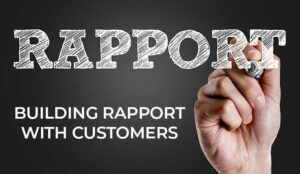Building rapport with customers is essential in today’s world.
Perhaps now more than ever, we want to build relationships with the brands we’re buying from. Analytical group McKinsey has stated that companies leading with empathy and understanding will be the ones most likely to survive following the 2020 pandemic.
However, there’s more to building a rapport with your customers than making small talk or asking them about their day when you’re connecting through the contact centre. Companies need to find a way of embedding emotional interactions into their service culture, to create a rapport capable of transcending challenges such as distance.
So, how do you build customer rapport the right way?
Step 1: Create the Right Service Culture
Building rapport requires genuine connections between businesses and their customers. Today’s customers are looking for authentic interactions, built on a company’s commitment to deliver the best possible experience. This means business leaders need to create a service culture that prioritises emotional relationships from day one.
Even in a world where employees are working away from the office, every staff member will need to follow the same guidelines for building connections with customers. This could mean giving your staff pop-ups on their screen with information about the customer they’re talking to, so they can personalise the conversation, and if conversations start to turn sour, supervisors could be given the opportunity to step in and offer assistance.
Step 2: Commit to Constant Learning
Establishing a genuine connection with customers means you need to understand them and their challenges. Collecting as much data as possible from your conversations is a crucial part of this process.
Real-time and historical data collection in the contact centre will make it easier to pluck trends from conversations, so you can determine which discussions often lead to positive customer satisfaction.
Service leaders and employees should be able to consistently monitor the quality of conversations, with the opportunity to track additional important metrics, such as customer satisfaction score or NPS rating.
Recording tools may need to be implemented to provide teams with training opportunities to learn from successful or unsuccessful calls. The more accurate data you can collect about contextual conversations, the more you’ll be able to take action to build customer rapport.
Step 3: Assist Employees
Having meaningful conversations with customers is more difficult than it may seem. Although your customers are looking for relevant, personalised experiences, they also want conversations to be managed with speed and efficiency. Employees can have a hard time balancing both sides at once.
Fortunately, there are tools available to help, including:
AI and Virtual Assistants:
Virtual assistants can collect information about customers to add to profiles, which allows for more contextual and consistent experiences over time. These assistants can also automatically surface information about a customer for a call centre agent, reducing the amount of time wasted during conversations.
Smart Routing:
Smart routing reduces the need to start the rapport-building process from scratch, by ensuring customers are routed back to the person they spoke to last, where possible.
The right tools can also ensure customers speaking to agents after transitioning from another channel won’t have to repeat themselves. For instance, a system can transfer information about a live chat session to an agent when a customer requests a sales call.
Integrations:
Integrations allow employees to collect information from various environments to break the ice in conversations. A sales staff member could use profile information about a lead from the CRM to find out what products they’ve purchased before.
This means they can ask about their previous experiences, before diving into a new sale.
Step 4: Maintain Humanity
In a world full of technology self-service and ultra-fast contact centre systems, it’s easy for the customer service environment to start looking like a well-oiled machine. On the one hand, this is excellent for efficiency and performance.
On the other hand, a machine-like experience isn’t always what customers are looking for. When understanding and mapping the customer journey, ensure you know when a human touch is needed.
Train employees in call centre etiquette and share recordings of previous successful conversations. Use real-time dashboards to allow employees to track the overall satisfaction rating of your employees, so they can see how their calls-per-minute to customer happiness ratio looks at any given time.
Even if you’re offering scripts to employees to help them with making sales, encourage your staff to ask questions, make (tasteful) jokes, pay compliments, and add a little humanity back into the discussion.
Step 5: Learn to Empathise
Building rapport with customers isn’t just about meaningless chit chat. While it’s sometimes nice to have a service representative or sales professional ask about your day, the reality is that customers want to see evidence that brands actually care about them.
This means you need to learn how to empathise with your customers, by actually listening to them.
Show your customers they’re valued by asking for their feedback and taking it into account. Collect as much information as you can in the form of reviews and suggestions for how you can improve your service. This way, you can place yourself into the shoes of your audience and discover what it really takes to make them happy.
Don’t just ask for your customer’s name and use it in every conversation; follow up on issues they’ve mentioned in the past and ask for suggestions on how they’d like you to improve. Focus on becoming genuinely people-first.
Connect With Your Customers
Building rapport with customers should be an essential part of your service culture, and something every member of staff does consistently. This doesn’t just mean you talk about the customer’s interests and ask about their projects in sales conversations.
It even goes beyond wishing customers a happy birthday or sharing personal anecdotes during discussions.
True customer rapport comes from a company’s ability to maintain empathy, humanity, and authenticity, while simultaneously leveraging the right tools for efficiency and performance. Don’t let the quest for digital transformation get in the way of your rapport-building strategy.
Author: Guest Author
Published On: 1st Sep 2021
Read more about - Guest Blogs, Akixi















